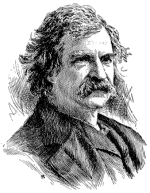The Boys’ Life of Mark Twain
by Paine

XLIII. Back to the River, With Bixby
Fortunately, Mark Twain was not greatly upset by his losses. They exasperated him for the moment, perhaps, but his violence waned presently, and the whole matter was put aside forever. His work went on with slight interference. Looking over his Mississippi chapters one day, he was taken with a new interest in the river, and decided to make the steamboat trip between St. Louis and New Orleans, to report the changes that had taken place in his twenty-one years of absence. His Boston publisher, Osgood, agreed to accompany him, and a stenographer was engaged to take down conversations and comments.
At St. Louis they took passage on the steamer “Gold Dust"–Clemens under an assumed name, though he was promptly identified. In his book he tells how the pilot recognized him and how they became friends. Once, in later years, he said:
“I spent most of my time up there with him. When we got down below
Cairo, where there was a big, full river–for it was high-water
season and there was no danger of the boat hitting anything so long
as she kept in the river–I had her most of the time on his watch.
He would lie down and sleep and leave me there to dream that the
years had not slipped away; that there had been no war, no mining
days, no literary adventures; that I was still a pilot, happy and
care-free as I had been twenty years before.”
To heighten the illusion he had himself called regularly with the four- o’clock watch, in order not to miss the mornings. The points along the river were nearly all new to him, everything had changed, but during high-water this mattered little. He was a pilot again–a young fellow in his twenties, speculating on the problems of existence and reading his fortunes in the stars. The river had lost none of its charm for him. To Bixby he wrote:
“I’d rather be a pilot than anything else I’ve ever been in my life.
How do you run Plum Point?”
He met Bixby at New Orleans. Bixby was a captain now, on the splendid new Anchor Line steamer “City of Baton Rouge,” one of the last of the fine river boats. Clemens made the return trip to St. Louis with Bixby on the “Baton Rouge"–almost exactly twenty-five years from their first trip together. To Bixby it seemed wonderfully like those old days back in the fifties.
“Sam was making notes in his memorandum-book, just as he always did," said Bixby, long after, to the writer of this history.
Mark Twain decided to see the river above St. Louis. He went to Hannibal to spend a few days with old friends. “Delightful days,” he wrote home, “loitering around all day long, and talking with grayheads who were boys and girls with me thirty or forty years ago.” He took boat for St. Paul and saw the upper river, which he had never seen before. He thought the scenery beautiful, but he found a sadness everywhere because of the decay of the river trade. In a note-book entry he said: “The romance of boating is gone now. In Hannibal the steamboatman is no longer a god.”
He worked at the Mississippi book that summer at the farm, but did not get on very well, and it was not until the following year (1883) that it came from the press. Osgood published it, and Charles L. Webster, who had married Mark Twain’s niece, Annie (daughter of his sister Pamela), looked after the agency sales. Mark Twain, in fact, was preparing to become his own publisher, and this was the beginning. Webster was a man of ability, and the book sold well.
“Life on the Mississippi” is one of Mark Twain’s best books–one of those which will live longest. The first twenty chapters are not excelled in quality anywhere in his writings. The remainder of the book has an interest of its own, but it lacks the charm of those memories of his youth–the mellow light of other days which enhances all of his better work.
 Continue...
Continue...![[Buy at Amazon]](http://images.amazon.com/images/P/B0006AHKG6.01.MZZZZZZZ.jpg)